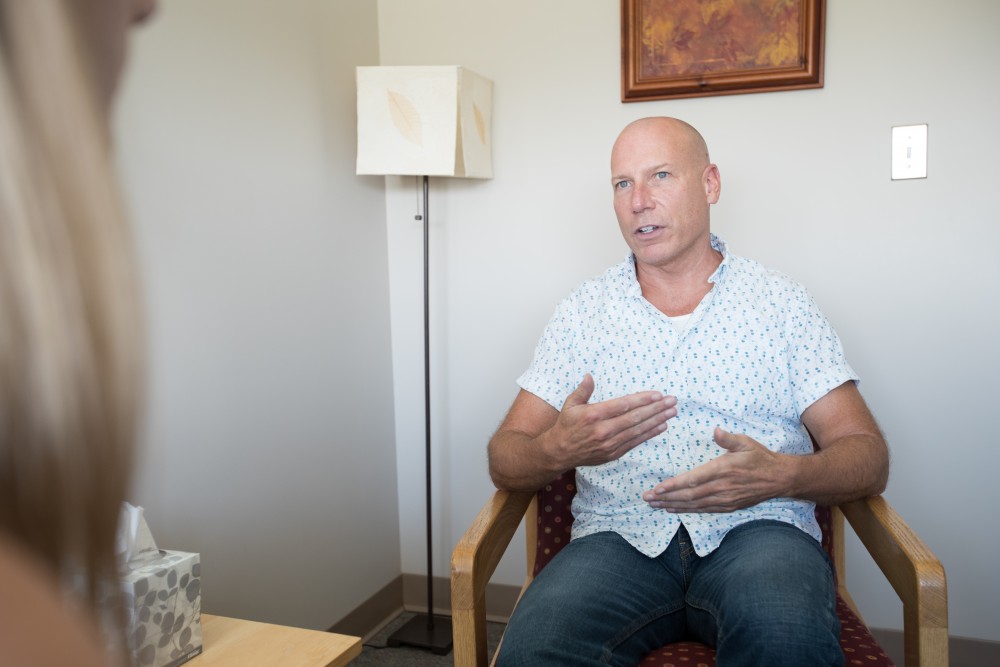Counseling center introduces a new triage screening system

GVL/Kevin Sielaff – PHOTO ILLUSTRATION: Mark Sampson, Associate Director and Director of Clinical Services for Grand Valley’s Counseling Center, stages a mock interview with a Grand Valley student.
Aug 29, 2016
Editor’s note: The image above is a staged photo illustration of a Grand Valley State University student and is not an actual Counseling Center client. The Counseling Center has strict rules about maintaining client confidentiality and does not allow photographs to be taken of actual clients.
In recent years, Grand Valley State University has been pushing for the destigmatization of mental health and illnesses, including hosting a mental health awareness week last year. GVSU’s Counseling Center has been at the forefront of that fight, working to help educate students, faculty and staff about mental health.
In its most recent undertaking to better serve students, GVSU’s Counseling Center introduced a triage system for students beginning Aug. 1 on both the Allendale and Pew campuses.
Mark Sampson, associate director and director of clinical services, described the triage system as an initial screening for students.
“The main reason we’re doing this is hopefully it gets our eyes on people sooner,” Sampson said. “A secondary thing is hopefully it makes our wait shorter, but that is yet to be seen.”
The new screening system will consist of students filling out paperwork and then having a 20-minute appointment with a therapist to assess their needs.
On average, Sampson said it currently takes about 10 days for GVSU students to be seen at the Counseling Center. He noted this is sooner than other college counseling centers, which could take up to a month to initially see students.
Ten days is still a long time to wait for high-risk clients, which can mean a student who feels suicidal or has something traumatic happening in their life, Sampson said.
“With this triage system, when they make their appointment, (it’s) a quick 20-minute appointment to assess services,” he said. “We also assess suicidality and substance abuse. We’re able to see that right away so if they need eyes on them, we can take care of that.”
In addition to high-risk students, the triage system will also help students who are looking to be put into a therapy group. Instead of waiting up to 10 days to be referred to a group therapy session, the triage system will allow therapists to swiftly refer that student the day they come in.
Sampson said this initial screening will also help those who may need help outside of the Counseling Center.
“Some people are beyond our scope of services, so it gets our eyes on them sooner to refer them to a resource that matches their needs better,” he said.
After launching in the beginning of August, they have received some feedback regarding the system. Sampson said the feedback comes in the form of confusion as to whom needs to go through the screening and who doesn’t.
“If a person is continuing with the same therapist, and if they’ve been here last year they do not have to do a screening,” he said. “If they want to see a new therapist, they do the screening. If they’ve never been in before or if they haven’t been in the past year, they do a screening.
“That’s just for us to kind of assess and make sure that they’re getting the right service.”
According to the National Data on Campus Suicide and Depression, one in every 12 college students has made a plan for suicide. With over 25,000 students at GVSU, that would make over 2,000 students who currently have or have previously made suicide plans.
The new triage system is a nationwide program attempting to help with the growing problem of suicide and depression on college campuses. Although the wait to see students is significantly shorter than other schools, GVSU’s Counseling Center has introduced the triage system earlier than most.
“We’re being more proactive,” Sampson said. “Before we need it, we’re doing it.”





















